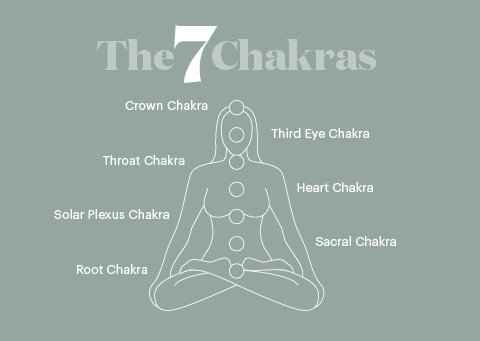Understanding the chakras of your body and how they can promote energy flow
Where the focus goes, the energy flows
Like movement and the food we eat, taking care of our spirit and our energy is an important part of self-care. When our energy flows freely we tend to feel more connected, in tune and at peace, which is why understanding the seven chakras of our body is so important, and why knowing how to tap into them via yoga can promote wellbeing, both mentally and physically.
The idea of chakras originated in India thousands of years ago, as a way to denote energy sources in the physical and spiritual body. Sanskrit for ‘wheel’, in the human body they are illustrated as spinning discs of energy that, when open, ensure a harmonious, balanced being.
Blocked chakras, however, can manifest as physical and emotional issues – from stress and anxiety to digestive issues or headaches. So, being in tune with your energy — and encouraging its free flow through yoga — is an important and transformative practice. Read on for more on the seven chakras, their purpose and how to tap into their power.

Root chakra (Muladhara)
The root chakra is located in the base of our spine and is linked to the foundations on which we build our life (basic needs like food, sleep and financial stability). Its colour is red, so when meditating on this chakra imagine a warm red light along the length of your spine. When the root chakra is balanced, you should feel grounded, secure, confident and safe.
Best asanas to tap into the power of Muladhara: Seek out grounding poses that build stability, such as warrior one, warrior two or mountain pose.
Sacral chakra (Swadhisthana)
The orange sacral chakra can be found just beneath the belly button and is linked to our sense of passion, creativity, sexuality and wellbeing. When the sacral chakra is balanced, life should feel pleasurable and your relationships with others should be fulfilling. When it is blocked, you might experience frustration, poor self-esteem or a lack of joy.
Best asanas to tap into Swadhisthana: Twisting or hip-opening asanas are effective at stimulating the sacral chakra, like bound angle pose, lizard pose, twisted monkey or reclined triangle pose.
Solar plexus chakra (Manipura)
The third chakra is our solar plexus chakra and it’s located in the stomach. This chakra is linked to our identity, our ego and confidence. When we think about ‘gut feelings’, this is the solar plexus chakra. Bright yellow in colour, a free-flowing solar plexus fosters self-worth, willpower and accomplishment.
Best asanas to tap into Manipura: Anything that builds internal heat or strengthens the abdominals is great for the solar plexus. Try boat pose, sun salutations (particularly in the sun) or twisting asanas from the stomach.
Heart chakra (Anahata)
The heart chakra links the lower chakras and the upper chakras, and influences our ability to love and be loved in return. Located in the centre of the chest and green in colour, a balanced heart chakra encourages generosity, compassion, openness and empathy. When out of alignment, we can feel lonely, insecure, and isolated.
Best asanas to tap into Anathata: Seal pose, camel pose, sphinx pose, and cobra pose are all heart-openers to unblock this chakra.
Throat chakra (Vishuddha)
Our throat chakra functions like the voice of our heart chakra, allowing us to communicate our truest self. Located in the throat and light blue in colour, it is essential to exercise Vishuddha to express yourself without doubt, shame or hesitation.
Best asanas: To stimulate and strengthen your throat chakra, practice asanas like bridge, fish pose, or shoulder stands.
Third eye chakra (Ajna)
Often referred to as our psychic ability or intuition, the third eye is located on the forehead between the eyes. Your third eye chakra enables you to envision the big picture, guiding you down the right path in life. Indigo in colour, think of this chakra as the control centre of your mind.
The third eye chakra also aligns with the pineal gland in the brain, which inputs all data and transfers it to the pituitary gland (responsible for turning this data into action within the body). According to stem-cell biologist and internationally recognised leader in mind-body medicine Bruce Lipton, the pineal gland is responsible for recognising our thoughts, our identity and our sense of intuition — so we can think of the third eye chakra as a direct energetic link.
Best asanas to tap into its power: Child's pose, with your third eye resting on your hands, is useful when it comes to tapping into this chakra. If you want to try a more powerful asana, replicate the same connection in dolphin pose.
Crown chakra (Sahasrara)
Purple or white in colour, the seventh and final chakra is the crown chakra, found at the very top of the head. Considered the highest and most spiritual, a fully open crown chakra gives us access to a higher consciousness. It is helpful to think of Sahasrara as a gateway as opposed to an energetic cross section, one that relies on the balance of all chakras beneath it. To have an open crown chakra is to experience true enlightenment.
Best asanas to tap into Sahasrara: Headstands, balancing butterfly pose and half lotus are all great when it comes to awakening the crown chakra.
So, whether you want to find balance, clear your voice, open your heart or tap into your sense of intuition, putting energy into your chakras via yoga is one of the most holistic practises you can do to promote energy flow in your body.
Want to dig a little deeper? Be sure to read our blog on intuition right here.
Reference: Think Beyond Your Genes, April 2020. Bruce H. Lipton,PhD.





